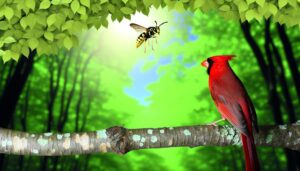Do Cardinals Have Yellow Chests?
Cardinals typically display red plumage, with males showing more intense hues due to carotenoids from their diet. However, genetic mutations, xanthochroism, can cause rare yellow chests in these birds.
Xanthochroism alters the carotenoid deposition pathway, replacing red pigments with yellow. Diet and environment also influence coloration.
Misidentification with birds like the Yellow-breasted Chat is common, but attention to morphology and bill shape confirms true cardinal sightings. Observing these rare mutations provides insights into avian genetics and pigment processes, contributing to the broader understanding of cardinals' phenotypic diversity.
Continued interest reveals further fascinating details.
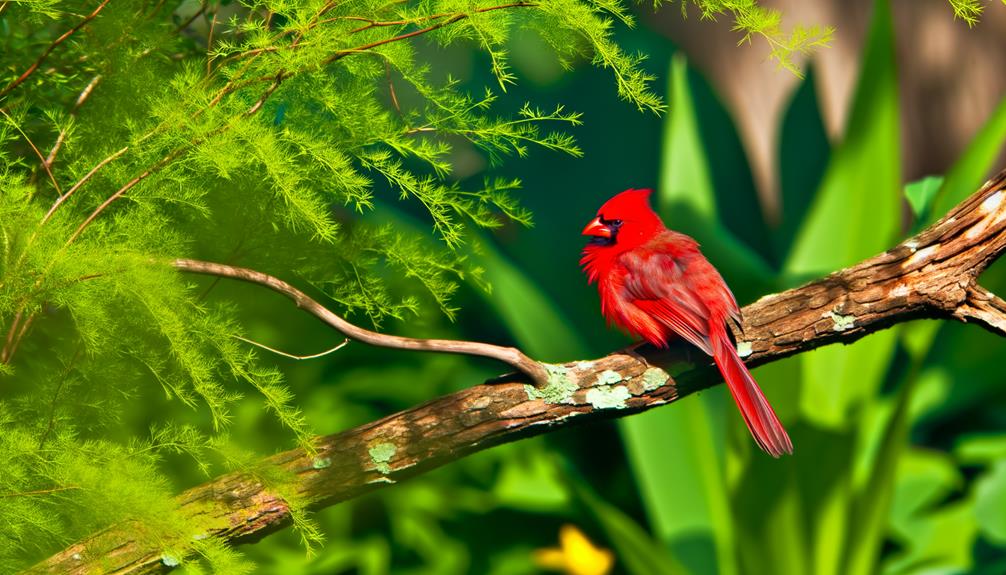
Key Takeaways
- Rare genetic mutations can cause cardinals to have yellow chests, a condition known as xanthochroism.
- Xanthochroism replaces the usual red pigments with yellow in some cardinals.
- Yellow pigmentation in cardinals is uncommon and results from altered pigment pathways.
- Environmental factors and diet can influence unusual yellow plumage in cardinals.
- Proper identification of yellow-chested cardinals requires focus on body color, chest, and wings.
Cardinal Coloration Basics
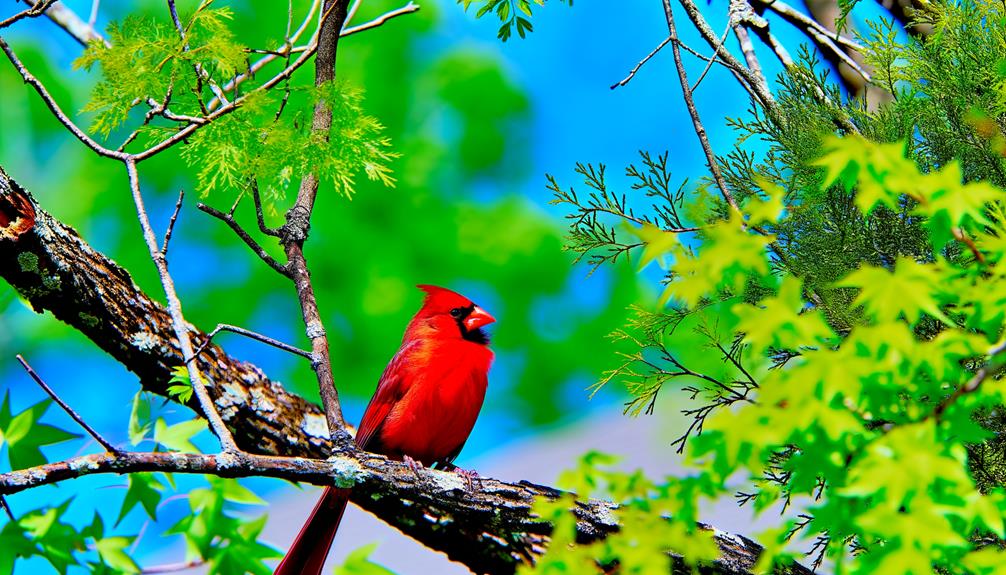
Cardinals, renowned for their vibrant plumage, exhibit a range of colors primarily dictated by their diet and genetic makeup. Carotenoids, pigments found in their food, play a significant role in their feather coloration. When cardinals consume carotenoid-rich foods like berries and seeds, these pigments are metabolized and deposited into their feathers.
Genetic factors also influence the intensity and hue of their plumage. Variations in gene expression can lead to different coloration patterns, providing a spectrum from bright reds to muted browns. Melanin, another pigment, contributes to the darker shades seen in some cardinals.
This complex interplay of diet and genetics guarantees that each cardinal displays a unique combination of colors, making their appearance both diverse and striking.
Typical Cardinal Colors
Most male Northern Cardinals display a vibrant red plumage, thanks to the high concentration of carotenoids in their diet. These carotenoids are pigments found in berries and fruits, which the cardinals consume, metabolize, and deposit in their feathers.
Female Northern Cardinals, on the other hand, exhibit a more subdued coloration, typically a mix of tan and brown with hints of red on the wings, crest, and tail. Their less conspicuous coloring aids in camouflage, providing protection while nesting.
Juvenile cardinals resemble females but with less definition in their markings. The bill of both sexes is a striking orange-red, contrasting with their facial mask, which is black in males and grayish in females. This color differentiation guarantees species recognition and mating success.
Rare Color Variants
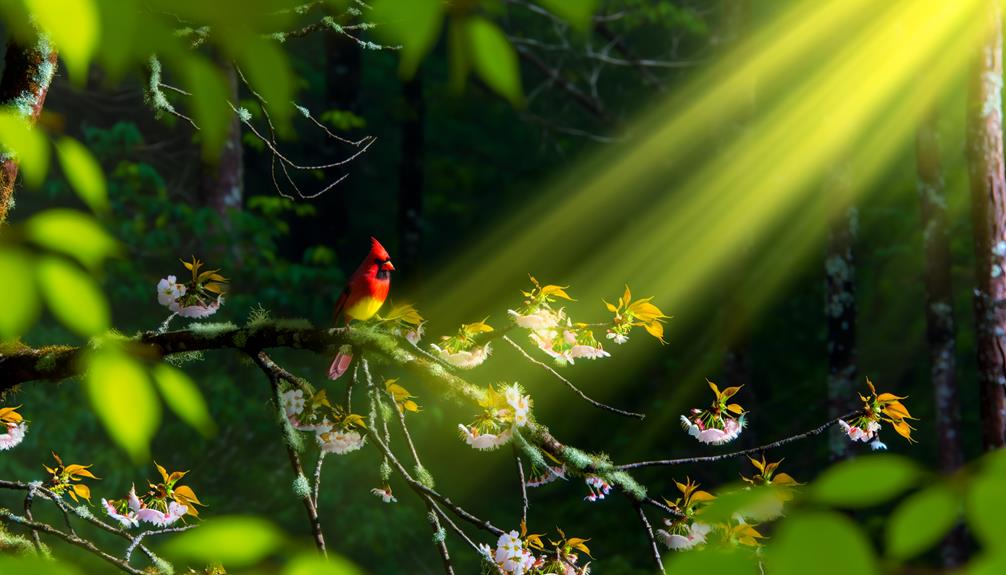
Occasionally, genetic mutations or dietary anomalies result in cardinals displaying rare color variants, such as yellow chests or leucistic plumage. These anomalies can create striking visual differences that intrigue ornithologists and bird enthusiasts alike.
The yellow variant, known as xanthochroism, occurs due to a lack of red pigmentation, replaced by yellow carotenoids. Leucism, a partial loss of pigmentation, can cause cardinals to appear pale or patchy.
- Xanthochroism: Absence of red pigments, replaced by yellow carotenoids.
- Leucism: Partial loss of pigmentation, leading to pale or patchy appearances.
- Dietary Influence: Variations in diet affecting pigment deposition.
Understanding these rare color variants helps researchers study genetic diversity and environmental influences on avian species, fostering a deeper appreciation for nature's variability.
Identifying a Yellow Cardinal
Identifying a yellow cardinal requires keen observation of its distinct yellow plumage, which results from xanthochroism and can be distinguished from the typical red coloration. This rare coloration occurs due to an altered pigment pathway, where carotenoids are deposited as yellow rather than red.
Observers should note the bird's overall body color, focusing on the chest, wings, and crest. Yellow cardinals retain the same morphology as their red counterparts, including the stout bill and black facial mask. For accurate identification, consider the bird's habitat and behavior, as these remain consistent across color morphs.
Birdwatchers should utilize binoculars and note-taking to document sightings, ensuring a precise record of this striking avian anomaly.
Genetic Mutations
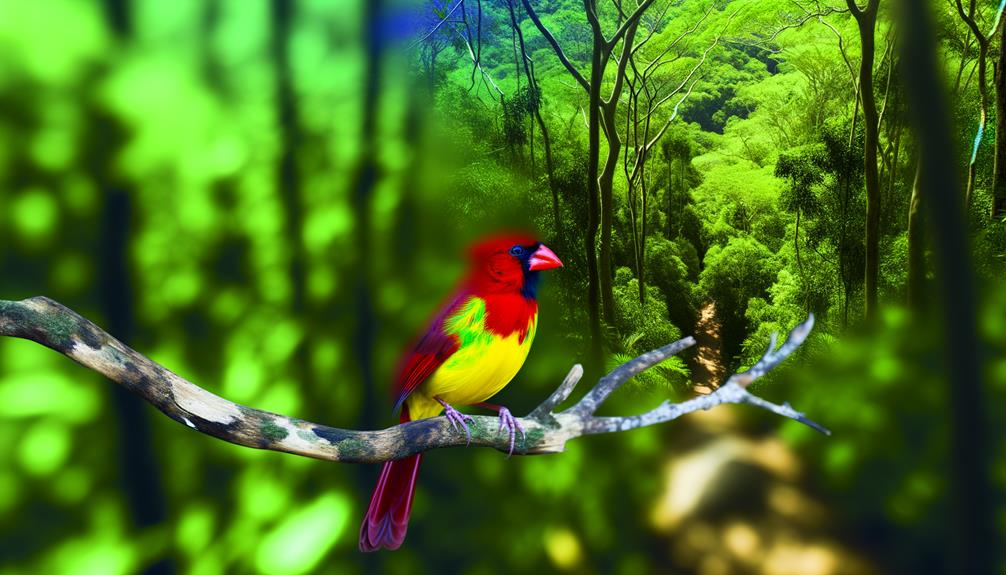
Genetic mutations can lead to rare color variations in cardinals, including the unexpected appearance of yellow plumage. These mutations impact the pigmentation processes, altering the bird's typical red coloration.
Understanding the genetic inheritance patterns of these mutations helps explain how such unique traits are passed down through generations.
Rare Color Variations
Rare color variations in cardinals, often resulting from genetic mutations, can lead to unexpected plumage colors such as yellow chests. These anomalies are uncommon but provide a fascinating glimpse into avian genetics and the diversity of nature.
- Xanthochroism: This genetic mutation replaces red pigments with yellow, often resulting in cardinals with striking yellow feathers.
- Leucism: Involving partial loss of pigmentation, this condition can cause patches of yellow on a cardinal's chest.
- Dietary Influence: Although less common, a cardinal's diet can sometimes influence unusual coloration, though this is typically less pronounced than genetic factors.
These color variations serve as a reminder of the complex interplay between genetics and environment in shaping the natural world, offering a spectrum of beauty beyond the norm.
Mutation Impact on Plumage
Understanding how genetic mutations impact plumage in cardinals reveals the intricate mechanisms behind their vibrant and sometimes unexpected coloration. Mutations in genes responsible for pigment production can lead to significant deviations from the typical red plumage.
For example, a mutation in the CYP2J19 gene, which influences carotenoid metabolism, might result in yellow or even orange feathers instead of red. Additionally, albinism and leucism are conditions caused by mutations that affect melanin production, leading to white or pale discolorations.
These variations showcase how genetic diversity can alter phenotypic expressions in cardinals. Researchers utilize these mutations to study evolutionary adaptations and ecological interactions, expanding our understanding of avian biology. Each mutation offers a window into the complex genetic tapestry of cardinal plumage.
Genetic Inheritance Patterns
Researchers have mapped the inheritance patterns of mutations affecting cardinal plumage, revealing how these genetic alterations are passed down through generations. They discovered that plumage color changes, such as the rare yellow chest, are often due to specific gene mutations. These mutations follow Mendelian principles, meaning they can be dominant or recessive.
The study identified key patterns:
- Autosomal Dominant Inheritance: A single copy of the mutated gene from either parent can cause the yellow chest.
- Autosomal Recessive Inheritance: Both parents must carry and pass on the mutated gene for the trait to manifest.
- Sex-Linked Traits: Some mutations are linked to sex chromosomes, affecting males and females differently.
This genetic mapping empowers breeders and enthusiasts with knowledge to predict and understand plumage variations.
Environmental Factors
Environmental factors profoundly influence the pigmentation patterns of cardinals, often leading to noticeable variations in their chest coloration. Microhabitat conditions, such as light exposure and temperature, can impact the synthesis of pigments like carotenoids and melanin.
Increased ultraviolet radiation has been observed to enhance the reddish hues, while shaded environments might result in less vibrant tones. Additionally, pollution and exposure to certain chemicals in the environment can disrupt normal pigment deposition, occasionally resulting in unusual colorations, including yellowish tints.
Seasonal changes also play a role; cardinals might exhibit brighter chests during breeding seasons due to hormonal influences and environmental cues. Hence, the interplay of these factors has a significant effect on the visual appearance of cardinals, contributing to their diverse and adaptable coloration.
Diet Influence
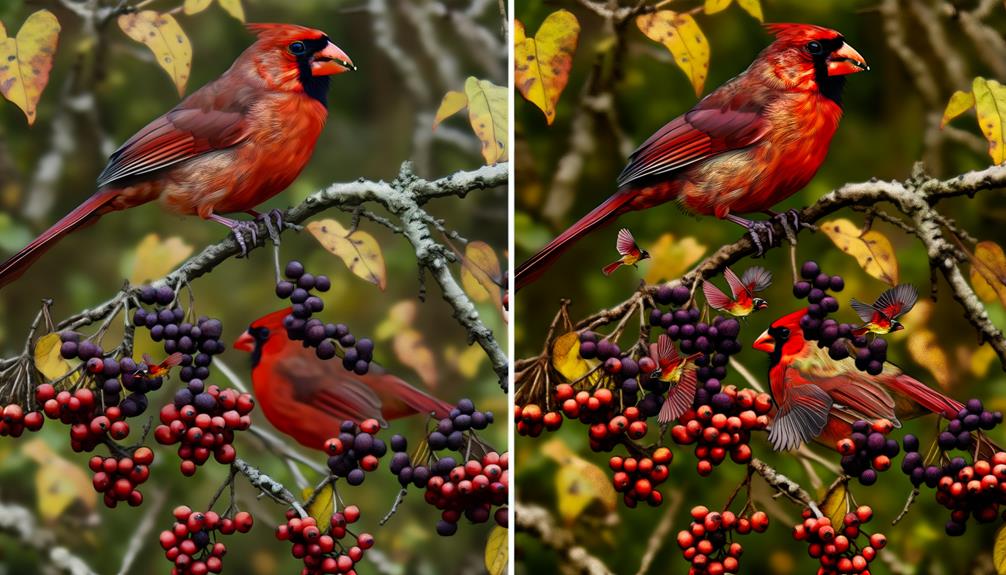
Diet greatly influences the plumage coloration in cardinals, particularly through the variety of food sources they consume and how their bodies absorb nutrients.
The presence of carotenoids in their diet, derived from fruits and seeds, plays an essential role in the pigmentation process.
Variations in diet can lead to differences in coloration, including the rare occurrence of yellow chests.
Food Source Variety
Observing a cardinal's diet reveals a diverse array of food sources that can influence the coloration of its plumage. Cardinals consume various seeds, fruits, and insects, each contributing distinct pigments to their feathers.
A meticulous examination of their feeding habits shows:
- Seeds: High in carotenoids, seeds like sunflower and safflower enhance the red hues in their plumage.
- Fruits: Berries such as mulberries and dogwood provide essential antioxidants and additional carotenoids.
- Insects: Protein-rich insects like caterpillars and beetles supplement their diet with necessary amino acids.
Nutrient Absorption Effects
Cardinals' vivid plumage arises from their effective absorption of dietary carotenoids, which are processed and stored in their feathers. These pigments, mainly sourced from their diet of fruits and seeds, go through metabolic transformation in the liver.
The altered pigments are then carried through the bloodstream to the feather follicles. Fluctuations in carotenoid intake can impact feather coloration, potentially influencing the bird's overall appearance. A diet lacking in these pigments may lead to less vibrant plumage, while a plentiful carotenoid diet guarantees the distinctive bright red coloration.
Remarkably, the enzymatic pathways involved in this metabolic process are highly specialized, highlighting the biological complexity behind the stunning hues. Therefore, diet plays an essential role in determining the cardinal's feather color intensity.
Regional Differences
Regional variations in cardinal plumage often lead to significant differences in coloration, including the rare occurrence of yellow chests. These anomalies are primarily observed in specific geographic locales, where environmental factors influence pigmentation. Researchers have identified distinct patterns that are regionally specific.
- Mid-Atlantic States: Cardinals in this region occasionally exhibit a lighter, almost yellowish hue on their chests due to genetic mutations.
- Southwestern USA: Here, cardinals might display a spectrum of colors ranging from standard red to orange and yellow, influenced by diet and habitat.
- Southeastern USA: The warmer climate and diverse flora can result in yellow pigmentation appearing sporadically in cardinal populations.
Understanding these regional differences is essential for ornithologists aiming to study the intricate mechanisms behind avian coloration.
Misidentified Birds
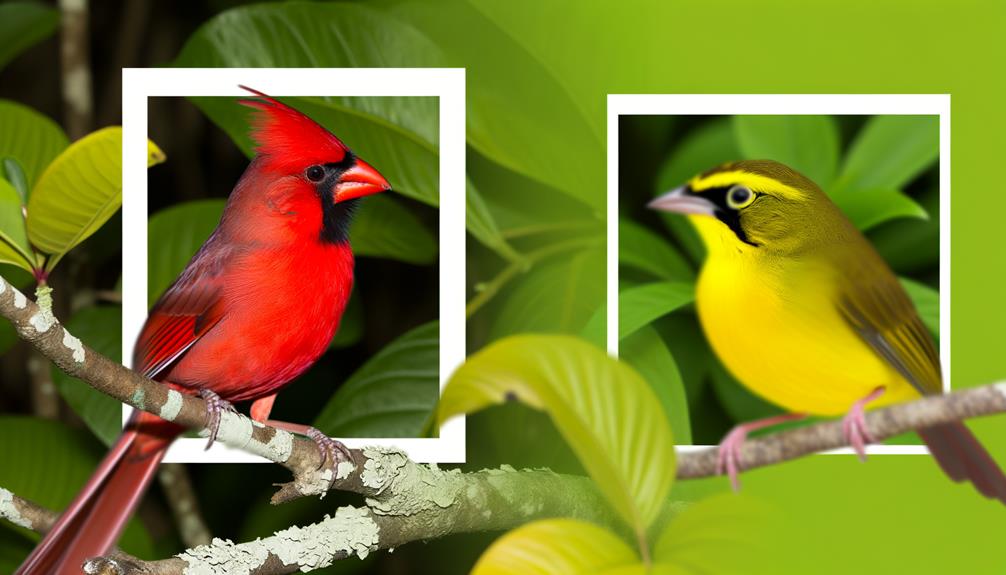
A common issue in ornithological studies is the frequent misidentification of other bird species as cardinals, particularly when unusual plumage variations, such as yellow chests, are observed.
This confusion often arises with species like the Yellow-breasted Chat (Icteria virens) and the Western Tanager (Piranga ludoviciana), which exhibit yellow plumage. Observers might hastily categorize these birds as cardinals due to overlapping habitats and superficial similarities in body morphology.
Proper identification requires careful attention to distinguishing characteristics such as beak shape, song patterns, and habitat preferences. Cardinalis cardinalis, the Northern Cardinal, consistently displays red plumage in males and tan to reddish hues in females, with no yellow chest.
Accurate identification is essential for scientific accuracy and informed birdwatching.
Birdwatching Tips
For effective birdwatching, enthusiasts should focus on selecting habitats rich in avian biodiversity, such as wetlands and mixed forests.
Essential gear includes high-resolution binoculars, a reliable field guide, and weather-appropriate clothing to maximize accurate identification and comfort.
Choosing Optimal Locations
To maximize cardinal sightings, birdwatchers should prioritize areas with dense, mixed hardwood forests and abundant underbrush. These habitats provide the necessary cover and food sources that cardinals thrive on.
Observers will find cardinals more frequently in regions where the environment supports a rich diversity of flora and fauna.
Key features of prime cardinal habitats include:
- Deciduous trees: Oaks, maples, and hickories offer both nesting sites and a plethora of insects.
- Shrubby undergrowth: Dense thickets of shrubs like dogwood and blackberry provide essential shelter and foraging grounds.
- Water sources: Proximity to streams or ponds guarantees a steady supply of water and attracts insects.
Essential Gear Checklist
Observing cardinals in their prime habitats requires birdwatchers to equip themselves with key gear items that enhance both the experience and accuracy of their sightings. High-quality binoculars with a magnification of 8×42 provide clear clarity and field of view. A lightweight field guide, such as the 'Sibley Guide to Birds,' aids in precise identification.
Birdwatchers should also carry a sturdy notepad and pencil for detailed observation notes. A compact, digital camera with a good zoom lens is crucial for capturing vivid images. Additionally, wearing camouflaged clothing minimizes disturbance to the birds.
A dependable smartphone app, like eBird, helps track sightings and share data with the birdwatching community. These essentials ensure a thorough and enjoyable birdwatching experience.
Scientific Studies
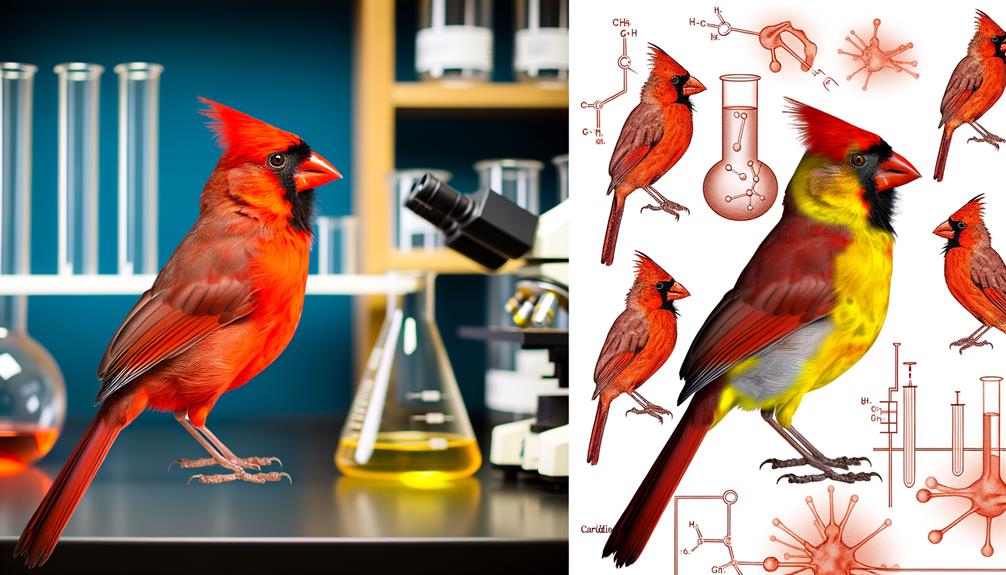
Several ornithological studies have meticulously examined the plumage variations in cardinals to determine the prevalence and significance of yellow chest feathers. Researchers utilized both field observations and controlled environments to gather detailed data. They found that yellow chest feathers in cardinals are exceedingly rare, often resulting from genetic mutations rather than diet or environmental factors.
- Genetic Analysis: DNA sequencing revealed specific mutations linked to unusual feather pigmentation.
- Field Observations: Observers documented instances of yellow chest feathers in less than 0.1% of the cardinal population.
- Controlled Experiments: Birds raised in identical conditions didn't develop yellow chests unless they possessed the genetic mutation.
These findings underscore the importance of genetic factors in plumage variation, offering a new perspective on avian biodiversity.
Conservation Concerns
Given the genetic basis of yellow chest feathers in cardinals, conservation efforts must prioritize the preservation of genetic diversity to maintain avian biodiversity. Habitat fragmentation reduces genetic variation, making populations vulnerable to diseases and environmental changes. Conservationists should focus on creating wildlife corridors to connect isolated populations.
Additionally, public awareness campaigns can encourage habitat preservation on private lands. Genetic studies reveal that interbreeding between different cardinal populations can enhance genetic resilience. Protecting natural habitats, such as forests and wetlands, safeguards that cardinals have the resources to thrive.
Lastly, monitoring programs should be established to track population changes and genetic health. By maintaining genetic diversity, conservationists help safeguard the long-term survival of cardinals with unique traits, like yellow chests.
Conclusion
While a yellow-chested cardinal may seem as rare as finding a golden needle in a haystack, they do exist due to genetic mutations. Just as a prism refracts light into unexpected colors, these unique cardinals challenge our understanding of avian pigmentation.
Birdwatchers should remain vigilant, as misidentifications are common. Scientific studies continue to shed light on these phenomena, reminding us that nature's palette is more diverse than we often realize, and conservation efforts must adapt accordingly.

